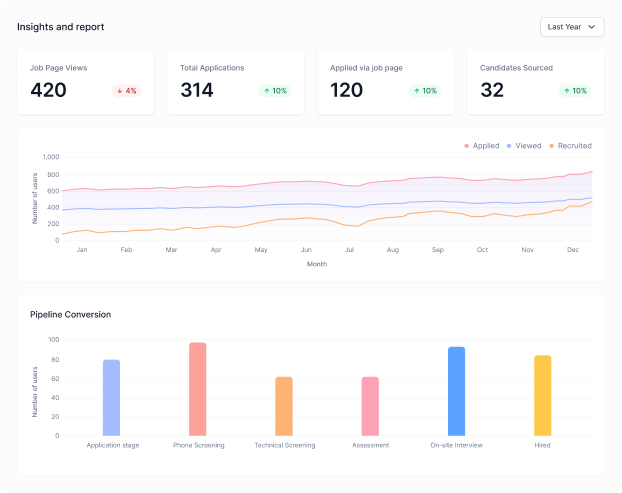Landing your dream job requires more than your skills and experience. In the current job market, your resume must get past the Applicant Tracking System, a tool that determines whether it gets to the hiring manager. This poses a challenge: how do job seekers create resumes that not only appeal to hiring managers but also pass through these digital gatekeepers?
The Applicant Tracking System(ATS) Conundrum: Friend or Foe?
Picture this: You invested a lot of time and resources into making what you deemed an attractive resume. You attach it to your job application, send it off, and await a positive response. Sadly, you are met with defeating silence or, even worse, an almost instantaneous rejection mail. Can you relate? Well, you are not the only one.
Applicant Tracking Systems seem to be the answer to the application overload companies and their recruiters face. The systems are designed to act as your applications’ first point of contact, scanning for specific keywords, qualifications, and formatting. For employers, this is godsent as it helps them streamline recruitment processes. For job seekers, however, the Applicant Tracking System is a potential nightmare.
According to Novaresume, 75% of resumes never make it past the watchful eye of the ATS. This means that even if you are the right fit for a role, you might never be considered if your resume does not make it past the system.
If you are wondering how best to optimize your resume for the Applicant Tracking System, you should consider leveraging Artificial Intelligence. Several AI-powered tools have emerged in recent years, proving to be a ton of help for candidates who want to take their resume from regular to ATS-optimized.
Keyword Wizardry
One of the things ATS looks out for in resumes is keywords. The ATS scans every resume that passes through, searching for keywords that have been splattered around the job postings. If your resume does not contain the required keywords, it will be ranked low or filtered out altogether. So, how can AI help you beat this? By providing keyword recommendations based on the job description.
For instance, if a job description is filled with phrases like “data-driven decision-making” or “cross-functional team leadership,” AI tools like Jobscan can suggest adding them to your resume. But while keywords are important, there’s a thin line between optimization and oversaturation.
AI tools excel at finding this balance, ensuring your resume reads naturally while still ticking all the right boxes for ATS. They can suggest synonyms and related terms, helping you diversify your language while staying relevant to the job description.
Format Like a Pro
Out with colorful resumes, in with functional resumes! If you believe putting extra effort into making your resume “look good” is the solution to the countless rejection emails you’ve received, you might want to drop that thought. As far as Applicant Tracking Systems are concerned, resumes with intricate graphics and fonts are blank pages.
While your aesthetically pleasing resume might catch the attention of a hiring manager, the ATS is not impressed. These systems are notoriously particular about resume formatting, often tripping over complex layouts and fancy fonts. With AI, you never have to worry about this.
Tools like ResumAI offer ATS-friendly templates that are both easy on the human eye and digestible for digital systems. They guide you toward designs that use standard fonts, clear section headings, and straightforward layouts. These templates strike the perfect balance between professional aesthetics and ATS compatibility, ensuring your resume doesn’t get lost in the applicant pool.
Tailoring: The Art of Resume Shape-Shifting
In your journey to landing that dream job, you must know that each job application requires a tailored, personalized approach. Particularly, Applicant Tracking Systems favor resumes that are more relevant to the job posting. But rewriting your resume for each application sounds like a nightmare.
AI-powered customization tools like Huntr can take your base resume and refine it to fit each job description perfectly. They’ll rearrange your experiences, adjust your skill emphases, and even suggest tweaks to your professional summary—all to align with the specific job you’re applying to.
These tools don’t just swap out keywords; they analyze the job description to understand the role’s priorities and adjust your resume accordingly. For instance, if a job emphasizes project management skills, AI might suggest moving your project-related achievements to a better position. The best part? All of this will only take a fraction of your time.
Grammar and Clarity: The Polish Your Resume Deserves
Keywords might get you past the ATS system, but it is the clarity and professionalism of your writing that’ll impress the human recruiter waiting on the other side. Leverage AI writing assistants like Grammarly and Hemingway Editor to act as your personal editors, catching those minor spelling errors and suggesting ways to make your achievements shine brighter.
Modern AI writing tools, however, go beyond catching spelling errors as they can analyze tone, suggest more impactful words, and even help you adjust your writing style to match industry expectations. For example, you might get suggestions prompting you to use more action verbs to describe your accomplishments or help you strike the right balance between confidence and humility in your professional summary.
Actionable Strategies to Help You Dominate Applicant Tracking Systems
Now that you understand how AI tools can help you create a resume that impresses the ATS and human recruiters, keep the following in mind:
- Embrace Simplicity: Ditch the fancy formatting. Clean, standard fonts and a straightforward layout are your best friends.
- Keyword Mastery: Use AI to identify and naturally incorporate key phrases from the job description.
- Quantify Like a Boss: Don’t just say you increased sales—tell them exactly how much. Numbers are attractive to ATS and human recruiters.
- Customize, Customize, Customize: Each application deserves its own tailored resume. Let AI do the heavy lifting for you.
Advanced Applicant Tracking Systems Tactics
- Leverage Long-Tail Keywords: While focusing on primary keywords, don’t neglect specific, less common phrases that might set you apart.
- Create a Skills Section: Many ATS give extra weight to a dedicated skills section. Use AI to identify and prioritize the most relevant skills for each application.
- Optimize File Names: Use a clear, professional file name for your resume. Some ATS consider this information.
- Include a LinkedIn Profile: Several Applicant Tracking Systems can parse LinkedIn profiles. Ensure yours is up-to-date and consistent with your resume.
The Human Touch: Balancing AI and Authenticity
While AI tools are invaluable, it’s crucial to remember that, ultimately, you’re trying to connect with human beings. Use AI to optimize and polish, but let your unique voice and experiences shine through. Employers aren’t just hiring a set of keywords—they’re hiring you.
Consider using AI suggestions as a starting point, then refining and personalizing the content to truly reflect your professional journey. Share anecdotes that highlight your problem-solving skills or leadership qualities. These personal touches can make your resume memorable once it passes the ATS and reaches the hiring manager.
The Future is AI (and So Is Your Career)
As AI continues to dominate the HR space, staying ahead of the curve is crucial. The good news? The same technology that powers ATS is now in your hands, leveling the playing field and giving your resume what it needs to shine.
From optimizing your resume to preparing for interviews and negotiating salaries, AI is your biggest ally in your career journey. By embracing these tools, you’re not just beating the system—you’re positioning yourself as a forward-thinking candidate ready to embrace and adapt to the new age of Artificial Intelligence.






